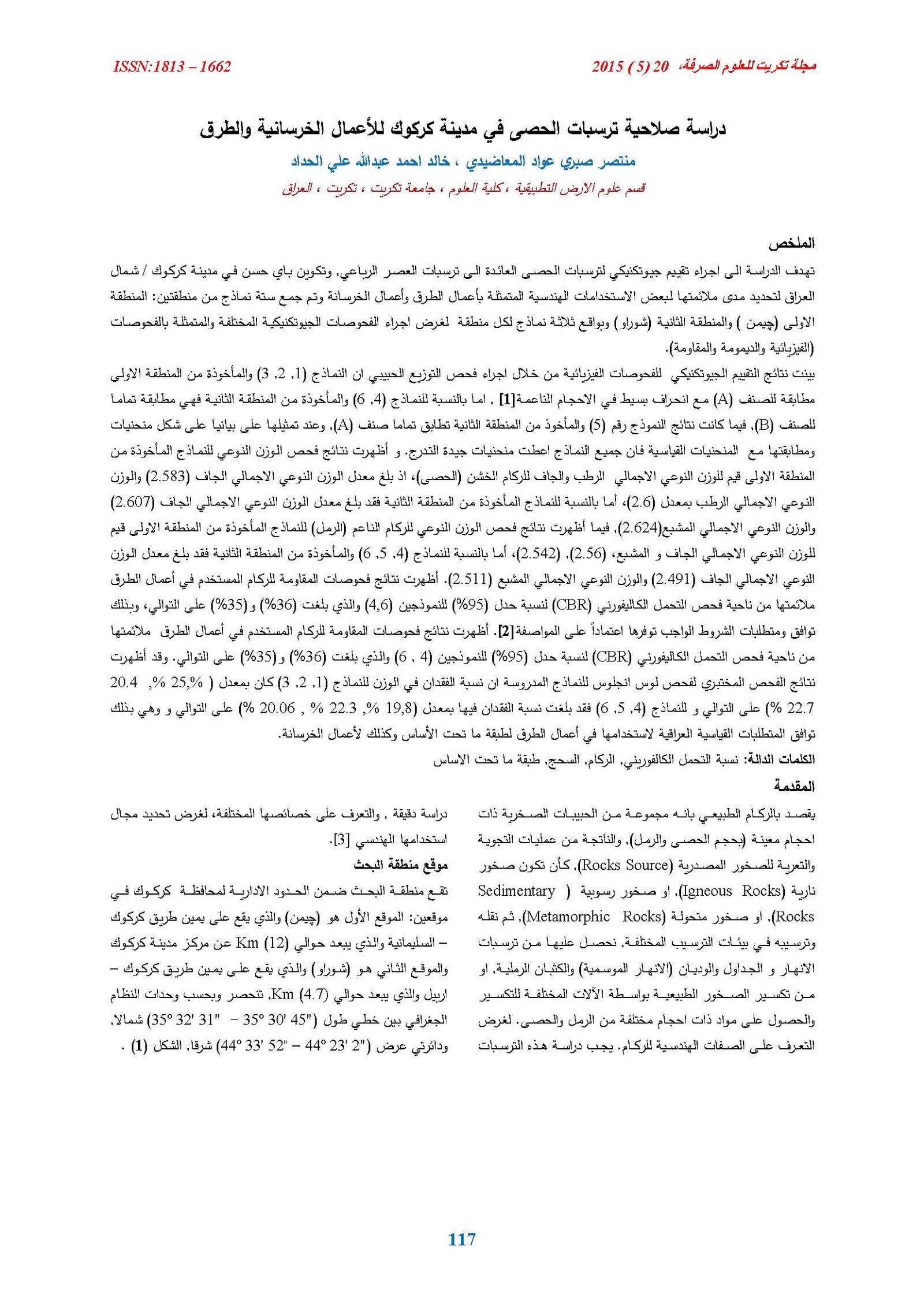Suitability of gravel deposits in Kirkuk city for concrete & roads works
Main Article Content
Abstract
The aim of research to a study some Engineering properties, Mechanical abrasion (Loss Anglos) test and Californian bearing ratio (CBR), with some physical properties such as optimum water content and specific gravity tests for aggregate deposits in Kirkuk / Iraq . Six samples taken from (Chiman) and (Shurau) sits , three samples from each sit which represented (Bai Hassan Formation) from (Shurau) sit , and Quaternary deposits from (Chiman) sit to estimate its resistance to abrasion and friction of the outer surface for course aggregate to show the suitability of geotechnical qualification of road layers and concrete works. The physical geotechnical evaluation results grain size distribution for samples (1, 2, 3) are matching for class (A) with simple shift in fine sizes according designation[1], while the samples (4, 6) are matching with class (B), while sample (5) matching exactly class (A), through represented the result as a curves and matching with standard curves all samples gave well graded curves. A results of specific gravity (dry, wet) of coarse aggregate (gravel) for samples (1, 2, 3) reached at average (2.583, 2.6) respectively, while a results of samples (4, 5, 6) reached at average (2.607, 2.624), and results of specific gravity (dry, wet) of fine aggregate (sand) for samples (1, 2, 3) reached at average (2.56, 2.542) respectively, while a results of samples (4, 5, 6) reached at average (2.491, 2.511), all the results within of limits that allowable according on American designation[2] between (2.3 – 3.2) . The strength tests (California bearing ratio) shows suitability to qualification needs to road works for sub base layer , where the values are (36%), (35%) respectively. Durability geotechnical tests (loss Angeles) results shows the weight loss for samples (1,2,3) are (% 20.4 ,% 25 , % 22.7) respectively, while for samples (4, 5, 6) the result are (19.80%, 22.3%, 20.06%) respectively. The Soundness test results for coarse aggregate (gravel) are (1.236%) for sample (1) and (1.062%) for sample (4) ,while the Soundness test results for fine aggregate (sand) are (2.897%) for sample (1) and (2.717%) for sample (4), so all samples are suitable to use in roads & concrete works .
Article Details

This work is licensed under a Creative Commons Attribution 4.0 International License.
Tikrit Journal of Pure Science is licensed under the Creative Commons Attribution 4.0 International License, which allows users to copy, create extracts, abstracts, and new works from the article, alter and revise the article, and make commercial use of the article (including reuse and/or resale of the article by commercial entities), provided the user gives appropriate credit (with a link to the formal publication through the relevant DOI), provides a link to the license, indicates if changes were made, and the licensor is not represented as endorsing the use made of the work. The authors hold the copyright for their published work on the Tikrit J. Pure Sci. website, while Tikrit J. Pure Sci. is responsible for appreciate citation of their work, which is released under CC-BY-4.0, enabling the unrestricted use, distribution, and reproduction of an article in any medium, provided that the original work is properly cited.
References
1- AASHTO , 2004: guide for testing materials.
2- American Society for Testing and Materials (ASTM D1883 – 99, 2004) Standard Test Method for CBR (California Bearing Ratio) of Laboratory-Compacted Soils" ,1-8 p.
3- McNally, G.H., 1998: "Soil and Rock Construction Materials", First published 1998 , E & FN Spon, an imprint of Routledge, New Fetter Lane, London EC4P , 401p.
4- American Society for Testing and Materials (ASTM D 75 – 03, 2004) : "Standard Practice for Sampling Aggregates", Volume 4, 1-5 p.
7- Jassim, S. Z. and Goff , J., C., 2006: "The regional geology of Iraq", 1st edition, Stratigraphy and Paleogeography, Dar Al-Kutib Pub. House, Mosul, Iraq, 445 p.
9- Buday, T. and Jassim, S.Z., 1987: The, Regional Geology of Iraq, Tectonism, Magmatism and Metamorphism, vol. 2, 352 p.
10- Sissakian, V.K., 1993: The Geology of Kirkuk Quadrangle, states Establishment of Geological survey and mining Geosurve, Report , 2229PP.
14- American Society for Testing and Materials (ASTM C 127 – 88, 2004): (Reapproved 2001) " Standard Test Method for Specific Gravity a Absorption of Coarse Aggregate" , Volume 4, p1-5.
15- American Society for Testing and Materials (ASTM D 93- 4318, 2004) Standard Test Methods for Liquid Limit, Plastic Limit, and Plasticity Index of Soils.
16- American Society for Testing and Materials (ASTM-C,131-96, 2004): “Standard Test Method for Resistance to Degradation of Small-Size Coarse Aggregate by Abrasion and Impact in the Los Angeles Machine ”, p4.
